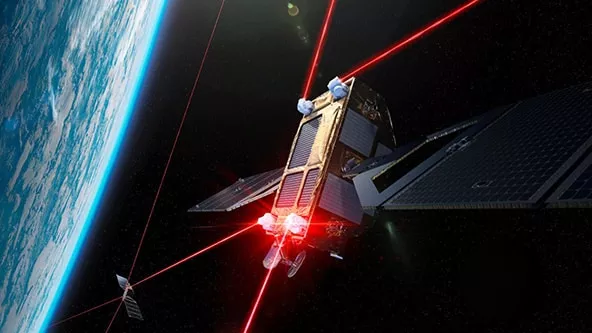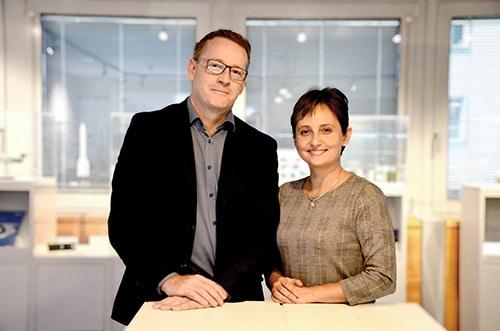
- The EU-funded UN:IO study’s goal is to establish a sovereign communications network for Europe to enable new services and bring applications such as CCAM, agricultural IoT, or smart manufacturing to any location in Europe and globally.
- The study aimed to deliver a concept for the first satellite constellation providing Deterministic Ethernet-based connectivity and data transfers. TTTech Aerospace investigated its Time-Triggered Ethernet and TSN technologies as candidates for providing the Quality-of-Service (QoS) demanded by the large number of use cases specified in the project
- If the good collaboration, research, and development continue, a first demonstrator may be operating in space as early as 2024
As part of the EU-funded UN:IO study[i] TTTech and the other project partners have evaluated the use of Time-Triggered Ethernet and Time-Sensitive Networking (TSN) technologies to improve Europe’s next generation secure satellite constellation. Results have been promising. The ambitious project aims to establish a sovereign communications network for Europe to enable safe and secure connectivity. The intended use cases include streaming and low-latency internet for real-time applications. Future constellations will support life on Earth by advancing autonomous vehicles, improving energy efficiency and reliability, and promoting IoT applications with the goal to foster connectivity, sustainability, and autonomy. A reliable and secure worldwide communication infrastructure is of the essence to make such applications successful.
Space infrastructure to benefit Earth
The world is becoming ever more connected and digitalized. To meet the constantly increasing need for fast, highly available internet services and digital communication infrastructure worldwide, total coverage is only feasible via satellite services. Satellite constellations are among the most promising solutions, as the transportation costs of the satellite into low Earth orbits (LEO) have dramatically decreased, along with the cost of the satellites themselves. In addition, new communication technologies like laser terminals and lower power, highly integrated semiconductors support radio frequency (RF) communications with higher bandwidth and efficiency.
The UN:IO study, funded with 1.25 million euros by the EU, recently carried out a feasibility study for a European secure satellite constellation to ensure a sovereign capacity for both governmental and commercial communication channels. The UN:IO study was carried out by a diverse consortium of organizations, including businesses and research institutions. A particular focus was placed on including many small and medium-sized companies (SME), some of them still start-ups, to foster innovation and to evaluate disruptive solutions, developed by new players in the space industry.

"Establishing global secure connectivity to overcome the missing broadband coverage and putting an end to 'dead' zones is a top priority for Europe. The safe and secure network connectivity for reliable data handling is a part of this ambitious goal,” says Anna Ryabokon, Senior Innovation Projects and Funding Manager at TTTech. Apart from formal requirements, such a network must also meet the EU’s sustainability vision and be extremely well protected against cyber attacks by quantum encryption. Ryabokon is confident the project team is up to the task: “Our consortium shows that we have all the necessary resources and know-how available here in Europe. One aim of the UN:IO study was to demonstrate that we have what it takes to build this sovereign European satellite constellation together. It will enable new services but also bring well-known applications, such as cooperative, connected, and automated mobility, agricultural IoT, smart manufacturing etc. to any location in Europe and globally.“
Ethernet-based connectivity for reliable communication
The UN:IO study aims to deliver a concept for the first satellite constellation providing Deterministic Ethernet-based connectivity and data transfers. TTTech Aerospace was tasked with investigating the use of its pioneering Ethernet-based technology as part of the project. Both Time-Triggered Ethernet and TSN technologies have been investigated as candidates for providing the Quality-of-Service (QoS) demanded by the high number of use cases specified in the project. TTTech was responsible for evaluating the benefits of using these QoS on-board, allowing to improve the overall constellation services with respect to low-latency, real-time and streaming communications on a satellite cluster.
Use cases cover diverse sectors such as governmental, automotive, transport, energy, manufacturing, health, and public safety. For many of them real-time data communication is essential and needs to coexist in parallel with high-speed streaming on the same satellite. Especially in highly automated scenarios like autonomous driving and flying, urban air mobility, or smart production, the most reliable data communication possible is required to rule out accidents and malfunction. Deterministic Ethernet and the automated dynamic generation of a network schedule simplifies the design of fault-tolerant and high availability solutions and scheduled data traffic is forwarded in an extremely precise way.
Applying TTTech networking technology to a satellite cluster
Contrary to other data-handling technologies in aerospace, TTEthernet enables time-triggered communication over standard Ethernet links, like those used in classical IT infrastructures. The prerequisite for time-triggered services is that they all establish and maintain the same concept of time, which is implemented by the close synchronization of every device’s local clock. The availability of global time through strict time synchronization in TTEthernet was formally verified by TTTech together with NASA and Stanford University in 2008, supporting the design of the NASA Orion Onboard Data Network (ODN). TTEthernet was also selected as avionics backbone in the European Space Agency’s Ariane 6 family of launchers.
The requirements posed by the UN:IO study’s satellite constellation are no less challenging: it will eventually consist of roughly 300 satellites operating on various (LEO, MEO, GEO) orbits, optimized to the intended QoS type provided (e.g. vehicle-to-vehicle communication or mobile telephony). A global scheduling and re-planning tool developed by TTTech identifies the latency and jitter compensation models needed for scheduling and configuration of the constellation network. It allows to automatically design a large system supporting different QoS for data connections requesting security, reliability, real time guarantees or simple high-bandwidth streaming. TTTech developed a small-scale scheduling model to assess the applicability of algorithms currently used on a spacecraft over a highly dynamic re-configurable satellite network cluster.
TSN boosts efficiency, bandwidth, and performance
For communication data flows and network scheduling, TTTech has chosen the Time Sensitive Networking (TSN) standard. “Even though it is a relatively new networking standard, TSN is built on deterministic communication technology developed by TTTech over years and is used in our current space product portfolio to support different QoS data flows. The latter allow the technology to provide services to IEEE802 Ethernet that significantly improve networked clusters”, says Ivan Masar, Space Senior Product Manager at TTTech Aerospace. “TSN has the capability to transmit time-sensitive data with defined latency over Ethernet networks covering a broad variety of applications where real-time communication coincides with non-critical Ethernet-based traffic. It provides the improved QoS performance needed for the huge number of connected devices and therefore will make a significant impact on the securely connected satellite constellations in UN:IO.”
First demonstrator in 2024

Within the comparatively short project duration of only six months, the UN:IO feasibility study has already yielded promising results. Time is of the essence: a first demonstrator may be operating in space as early as 2024, followed by hundreds of satellites, various laser ground stations, several control centers and other operational infrastructure. By 2025, Europe’s own satellite constellation may already be orbiting the globe – if the good collaboration continues. Christian Fidi, Senior Vice President Business Unit Aerospace at TTTech Group: “We are sure that we can significantly improve the QoS of this satellite cluster with the technologies we have developed over the past 25 years. It is important to use the current momentum to start a follow-up project as soon as possible. To make such an endeavor successful, government, academia and businesses need to continue pushing technology, products, and the infrastructure forward. We are proud to be part of such a consortium and for the support of the EU in developing this strategically important infrastructure.”
Find out more:
[i] The European Commissions called for a study titled: “DEFIS/2021/OP/0005 - New space solutions for long term availability of reliable, secure, cost-effective, space-based connectivity”. Based on this call, the companies Reflex Aerospace, Isar Aerospace and Mynaric formed the UN:IO consortium and subcontracted 11 other EU companies and institutions to carry out the study work together. In the meantime, the independent company UN:IO Enterprise GmbH has been established by Reflex Aerospace, Isar Aerospace, Mynaric and SES. This article is in relation to the UN:IO study, not the company.